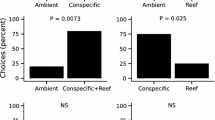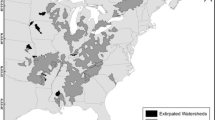Abstract
For species living in highly variable environments, the ability to perceive and respond to environmental cues by moving into favorable habitats should convey evolutionary advantages. Here we examined the spatial dynamics of an Amazonian pencil fish species that shows seasonally varying use of stream channel and temporary pool habitats. We hypothesized that movement into the pools should be driven by cues that reflect availability of spawning sites, whereas movement out of the pools should be driven by cues that help avoid entrapment as water level declines. Survival, detection, and movement probabilities were estimated from capture histories of individuals recorded on 13 surveys along a hydrological cycle. Differences between habitats were small for detection probability and survival. Movement from stream to pools was greatest during bankfull overflow, whereas movement from pools to stream was related to rapid decline in pool area. Entry to pools during overflow may allow fish to choose favorable spawning sites while still permitting a swift return to the stream if conditions in pools deteriorate. The ability to interpret hydrological cues seems to allow pencil fish to cope with environmental uncertainty by timing its use of seasonally available spawning sites while avoiding entrapment in desiccating pools.

Source Coordination of Environmental Dynamics, CDAM, INPA; b Seasonal variation in total pool area along the 50-m study stretch in Reserva Ducke. Area measurements for 13 surveys conducted along one seasonal rainfall cycle are shown. Vertical dashed lines correspond to survey dates



Similar content being viewed by others
References
Bauer, S., B. A. Nolet, J. Giske, J. W. Chapman, S. Åkesson, A. Hedenström & J. M. Fryxell, 2011. Cues and decision rules in animal migration. In Milner-Gulland, E. J., J. M. Fryxell & A. R. E. Sinclair (eds), Oxford University Press, New York: 68–87.
Bénech, V. & M. Peñáz, 1995. An outline on lateral fish migrations within the Central Delta of the Niger River, Mali. Hydrobiologia 303: 149–157.
Breininger, D. R., J. D. Nichols, G. M. Carter & D. M. Oddy, 2009. Habitat-specific breeder survival of Florida scrub-jays: inferences from multistate models. Ecology 90: 3180–3189.
Calvert, A. M., S. J. Bonner, I. D. Jonsen, J. M. Flemming, S. J. Walde & P. D. Taylor, 2009. A hierarchical Bayesian approach to multi-state mark–recapture: simulations and applications. Journal of Applied Ecology 46: 610–620.
Cossette, C. & M. A. Rodríguez, 2004. Summer use of a small stream by fish and crayfish and exchanges with adjacent lentic macrohabitats. Freshwater Biology 49: 931–944.
DeAngelis, D. L., J. C. Trexler & W. F. Loftus, 2005. Life history trade-offs and community dynamics of small fishes in a seasonally pulsed wetland. Canadian Journal of Fisheries and Aquatic Sciences 62: 781–790.
Development Core Team, R., 2015. R: a language and environment for statistical computing. R Foundation for Statistical Computing, Vienna.
Doherty, P. F., G. C. White & K. P. Burnham, 2010. Comparison of model building and selection strategies. Journal of Ornithology 152: 317–323.
Dupuis, J. A., 1995. Bayesian estimation of movement and survival probabilities from capture- recapture data. Biometrika 82: 761–772.
Espírito-Santo, H. M. V. & J. Zuanon, 2016. Temporary pools provide stability to fish assemblages in Amazon headwater streams. Ecology of Freshwater Fish. doi:10.1111/eff.12292.
Espírito-Santo, H. M. V., W. E. Magnusson, J. Zuanon, F. P. Mendonça & V. L. Landeiro, 2009. Seasonal variation in the composition of fish assemblages in small Amazonian forest streams: evidence for predictable changes. Freshwater Biology 54: 536–548.
Espírito-Santo, H. M. V., M. A. Rodríguez & J. Zuanon, 2013. Reproductive strategies of Amazonian stream fishes and their fine-scale use of habitat are ordered along a hydrological gradient. Freshwater Biology 58: 2494–2504.
Fernandes, C. C., 1997. Lateral migration of fishes in Amazon floodplains. Ecology of Freshwater Fish 6: 36–44.
Finer, M. & C. N. Jenkins, 2012. Proliferation of hydroelectric dams in the Andean Amazon and implications for Andes-Amazon connectivity. PLoS ONE 7(1–9): e35126.
Fraga, R. D., A. P. Lima, A. D. C. Prudente & W. E. Magnusson, 2013. Guide to the Snakes of the Manaus Region, Central Amazonia. Editora INPA, Manaus.
Fraser, D. F. & J. F. Gilliam, 1992. Nonlethal impacts of predator invasion: facultative suppression of growth and reproduction. Ecology 73: 959–970.
Fretwell, S. D. & J. H. L. Lucas, 1970. On territorial behavior and other factors influencing habitat distribution in birds. I. Theoretical development. Acta Biotheoretica 1: 16–35.
Gelman, A. & J. Hill, 2007. Data analysis using regression and multilevel/hierarchical models. Cambridge University Press, New York.
Gelman, A., J. Hwang & A. Vehtari, 2014. Understanding predictive information criteria for Bayesian models. Statistics and Computing 24: 997–1016.
Gibb, A. C., M. A. Ashley-Ross, C. M. Pace & J. H. Long Jr., 2011. Fish out of water: terrestrial jumping by fully aquatic fishes. Journal of Experimental Zoology 315: 649–653.
Goulding, M., 1989. The fishes and the forest, explorations in amazonian natural history. University of California Press, Los Angeles.
Hamada, N., J. L. Nessimian & R. B. Querino, 2014. Insetos Aquáticos na Amazônia Brasileira: Taxonomia, Biologia e Ecologia. Editora INPA, Manaus.
Hohausová, E., G. H. Copp & P. Jankovsky, 2003. Movement of fish between a river and its backwater: diel activity and relation to environmental gradients. Ecology of Freshwater Fish 12: 107–117.
Huntsman, A. G., 1948. Freshets and fish. Transactions of the American Fisheries Society 75: 257–266.
Jensen, A. J., T. G. Heggberget & B. O. Johnsen, 1986. Upstream migration of adult Atlantic salmon, Salmo salar L., in the River Vefsna, northern Norway. Journal of Fish Biology 29: 459–465.
Junk, W. J., P. B. Bayley & R. E. Sparks, 1989. The flood pulse concept in river-floodplain systems. Canadian Special Publication in Fisheries and Aquatic Sciences 106: 110–127.
Kéry, M. & M. Schaub, 2012. Bayesian population analysis using winbugs—a hierarchical perspective. Academic Press, Burlington.
Knöppel, H.-A., 1970. Food of central amazon fishes. Amazoniana 2: 237–352.
Kwak, T. J., 1988. Lateral movement and use of floodplain habitat by fishes of the Kankakee River, Illinois. American Midland Naturalist 120: 241–249.
Lebreton, J.-D., J. D. Nichols, R. J. Barker, R. Pradel & J. A. Spendelow, 2009. Modeling individual animal histories with multistate capture–recapture models. In Caswell, H. (ed), Vol. 41. Elsevier Ltd., Burlington: 87–173.
Lima, A. P., W. E. Magnusson, M. Menin, L. K. Erdtmann, D. J. Rodrigues, C. Keller & W. Hödl, 2006. Guide to the Frogs of Reserva Adolpho Ducke, Central Amazonia. Editora INPA, Manaus.
Lyon, J., I. Stuart, D. Ramsey & J. O’Mahoney, 2010. The effect of water level on lateral movements of fish between river and off-channel habitats and implications for management. Marine and Freshwater Research 61: 271–278.
Martins, M. & M. E. Oliveira, 1999. Natural history of snakes in forest in the Manaus region, Central Amazonia, Brazil. Herpetological Natural History 6: 78–150.
McLinn, C. M. & D. W. Stephens, 2006. What makes information valuable: signal reliability and environmental uncertainty. Animal Behaviour 71: 1119–1129.
McNamara, J. M., Z. Barta, M. Klaassen & S. Bauer, 2011. Cues and the optimal timing of activities under environmental changes. Ecology Letters 14: 1183–1190.
Mendonça, F. P., W. E. Magnusson & J. Zuanon, 2005. Relationships between habitat characteristics and fish assemblages in small streams of central Amazonia. Copeia 2005: 751–764.
Osorio, D., J. Terborgh, A. Alvarez, H. Ortega, R. Quispe, V. Chipollini & L. C. Davenport, 2011. Lateral migration of fish between an oxbow lake and an Amazonian headwater river. Ecology of Freshwater Fish 20: 619–627.
Pace, C. M. & A. C. Gibb, 2014. Sustained periodic terrestrial locomotion in air-breathing fishes. Journal of Fish Biology 84: 639–660.
Pazin, V. F. V., W. E. Magnusson, J. Zuanon & F. P. Mendonça, 2006. Fish assemblages in temporary ponds adjacent to “terra-firme” streams in Central Amazonia. Freshwater Biology 51: 1025–1037.
Pelicice, F. M. & A. A. Agostinho, 2008. Fish-passage facilities as ecological traps in large Neotropical rivers. Conservation Biology 22: 180–188.
Plummer, M., 2003. JAGS: a program for analysis of Bayesian graphical models using Gibbs sampling. Proceedings of the 3rd International Workshop on Distributed Statistical Computing, Viena.
Plummer, M., 2006. CODA: convergence diagnosis and output analysis for MCMC. R News 6: 7–11.
Plummer, M., 2014. Rjags: Bayesian graphical models using MCMC. R package version 3–13.
Poirier, J. M., T. A. Whitesel & J. R. Johnson, 2012. Chum salmon spawning activity in tributaries below Bonneville dam: the relationship with tailwater elevation and seasonal precipitation. River Research and Applications 28: 882–892.
Robertson, B. A. & R. L. Hutto, 2006. A framework for understanding ecological traps and an evaluation of existing evidence. Ecology 87: 1075–1085.
Rodrigues, D. J., A. P. Lima, W. E. Magnusson & F. R. C. Costa, 2010. Temporary pond availability and tadpole species composition in central Amazonia. Herpetologica 66: 124–130.
Rosenzweig, M. L., 1981. A theory of habitat selection. Ecology 62: 327–335.
Royle, J. A. & K. V. Young, 2008. A hierarchical model for spatial capture-recapture data. Ecology 89: 2281–2289.
Rypel, A. L., K. M. Pounds & R. H. Findlay, 2012. Spatial and temporal trade-offs by bluegills in floodplain river ecosystems. Ecosystems 15: 555–563.
Schlaepfer, M. A., M. C. Runge & P. W. Sherman, 2002. Ecological and evolutionary traps. Trends in Ecology & Evolution 17: 474–480.
Schofield, M. R., R. J. Barker & D. I. MacKenzie, 2009. Flexible hierarchical mark-recapture modeling for open populations using WinBUGS. Environmental and Ecological Statistics 16: 369–387.
Stoffels, R. J., K. R. Clarke, R. A. Rehwinkel & B. J. McCarthy, 2014. Response of a floodplain fish community to river-floodplain connectivity: natural versus managed reconnection. Canadian Journal of Fisheries and Aquatic Sciences 71: 236–245.
Stoffels, R. J., R. A. Rehwinkel, A. E. Price & W. E. Fagan, 2016. Dynamics of fish dispersal during river-floodplain connectivity and its implications for community assembly. Aquatic Sciences 78: 355–365.
Súarez, Y. R., M. Petrere-Júnior & A. C. Catella, 2004. Factors regulating diversity and abundance of fish communities in Pantanal lagoons, Brazil. Fisheries Management and Ecology 11: 45–50.
Tomasella, J., M. G. Hodnett, L. A. Cuartas, A. D. Nobre, M. J. Waterloo & S. M. Oliveira, 2008. The water balance of an Amazonian micro-catchment: the effect of interannual variability of rainfall on hydrological behaviour. Hydrological Processes 22: 2133–2147.
Trépanier, S., M. A. Rodríguez & P. Magnan, 1996. Spawning migrations in landlocked Atlantic salmon: time series modelling of river discharge and water temperature effects. Journal of Fish Biology 48: 925–936.
Urban, D. & T. Keitt, 2001. Landscape connectivity: a graph-theoretic perspective. Ecology 82: 1205–1218.
Vogt, R. C., 2008. Tartarugas da amazônia. Grafico Biblos, Lima.
Williams, D. D., 2006. The biology of temporary waters. Oxford University Press, New York.
Williams, B. K. & J. D. Nichols, 1984. Optimal timing in biological processes. The American Naturalist 123: 1–19.
Winemiller, K. O., 1989. Patterns of variation in life history among South American fishes in seasonal environments. Oecologia 81: 225–241.
Winemiller, K. O. & D. B. Jepsen, 1998. Effects of seasonality and fish movement on tropical river food webs. Journal of Fish Biology 53: 267–296.
Acknowledgements
We thank Sr. J. Lopes, M. Carvalho, J. Sodré, P. Guarido, C. Gualberto, M. Guimarães, O. “Juruna” Pereira, T. Bicudo, R. Leitão, M. Pedrosa, D. Bastos, and C. Freitas for field assistance. HMVES thanks Conselho Nacional de Desenvolvimento Científico e Tecnológico (CNPq) for doctoral and postdoctoral scholarships and Coordenação de Aperfeiçoamento de Pessoal de Nível Superior (CAPES) for international internship support; MAR thanks the Natural Sciences and Engineering Research Council of Canada for financial support (#4865). JZ receives a productivity grant from CNPq (#313183/2014-7). Supplementary logistical support was provided by Projetos Ecológicos de Longa Duração (PELD) and Programa de Pesquisa em Biodiversidade (PPBio). CNPq and Fundação de Amparo à Pesquisa do Estado do Amazonas (FAPEAM) provided long-term financial support to Projeto Igarapés. This is contribution # 47 of Projeto Igarapés.
Author information
Authors and Affiliations
Corresponding author
Additional information
Handling editor: Alison King
Rights and permissions
About this article
Cite this article
Espírito-Santo, H.M.V., Rodríguez, M.A. & Zuanon, J. Strategies to avoid the trap: stream fish use fine-scale hydrological cues to move between the stream channel and temporary pools. Hydrobiologia 792, 183–194 (2017). https://doi.org/10.1007/s10750-016-3054-6
Received:
Revised:
Accepted:
Published:
Issue Date:
DOI: https://doi.org/10.1007/s10750-016-3054-6




